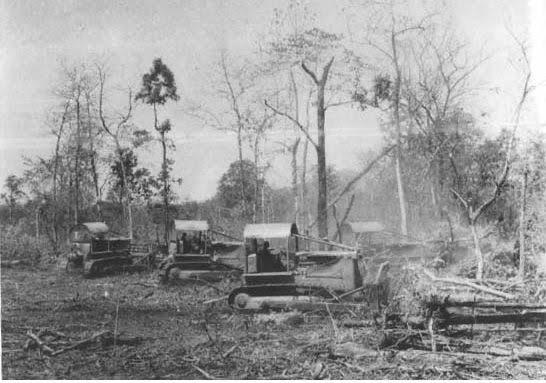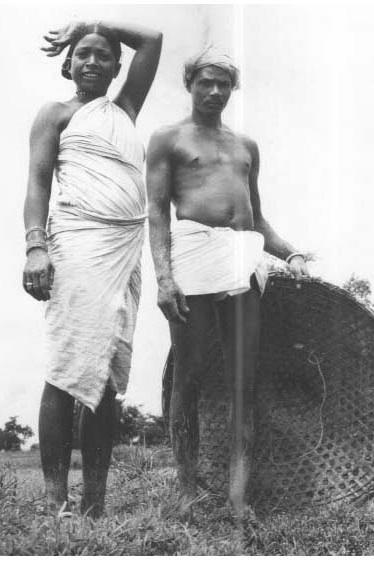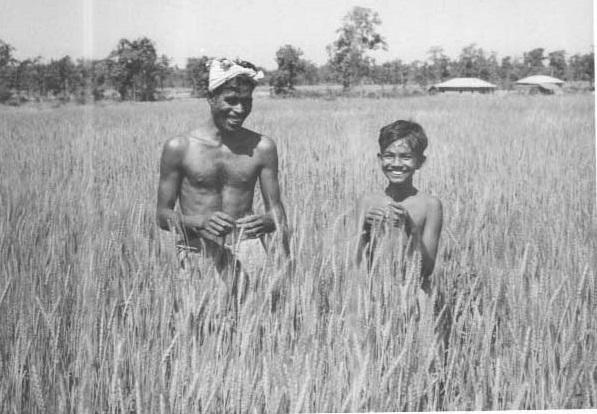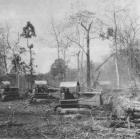The years 1956–1987 marked a shift in the cultivation of millets within central India’s Dandakaranya Forest. Indigenous communities in the forest had traditionally cultivated millets. Yet in the decades following Independence, the Indian government instituted a comestible hierarchy wherein rice was designated as “superior” to millets, with profound impacts on the region’s ecology. Rice needs 2,500 millimeters of water, whereas millets require only 200–300 millimeters, making them ideally suited to the Dandakaranya region with its scarce rainfall. Rice has required forest clearing; millets can be sustainably grown without degrading the forest ecology. Moreover, millets are more nutritionally dense than rice. Yet Indigenous foodways were disrupted to make way for crops grown by Partition refugees. The contest between millet and rice demonstrates how Indigenous farmers were coercively assimilated into the global food system by means of a government policy to make use of refugee cultivators to transform local crop cultivation.

Fig.1. Deforestation by the Dandakaranya Development Authority. Partition refugees cleared Dandakaranya Forest as part of the Indian government’s rehabilitation scheme.
Fig.1. Deforestation by the Dandakaranya Development Authority. Partition refugees cleared Dandakaranya Forest as part of the Indian government’s rehabilitation scheme.
Photo by Shri Govindala Vora. Accessed via Flickr. Click here to here to view source. Courtesy of the Smithsonian Institute. False copyright flag on Flickr. Click here to find out more about Smithsonian images in the public domain.
 This work is licensed under a Creative Commons Public Domain Mark 1.0 License.
This work is licensed under a Creative Commons Public Domain Mark 1.0 License.
The impetus for this major agricultural shift was a resettlement project—the Dandakaranya Project—conceived in 1956 to rehabilitate Partition refugees from East Bengal (present-day Bangladesh) by sending them to Dandakaranya Forest. Refugees were resettled on Indigenous homelands with the official rationalization that this was a way for the Indian state to develop “backward” areas. Government experts drew on the principles of colonial-era scientific forestry, which considered forests marginal or wastelands. The region was inhabited by adivasis (Indigenous communities), including tribes such as the Gond, Baiga, and Dongria Kondh, who cultivated and consumed millets. The environmental impacts of the resettlement project are of relevance here. If the land was yielding nutritious millets, why was it designated as marginal or wasteland? Conversion meant that millets would be replaced by hybrid crops (such as rice), which were then neither grown nor eaten by adivasis.
Refugee settlements were deforested prior to the establishing of homes, and refugee families aided in forest degradation as they gathered firewood, uprooted saplings, and earned their meagre daily wages in the work of forest clearing—in addition to the cultivation of hybrid crops. Over the course of the resettlement, more than 77,938 square kilometers (30,092 square miles) were deforested.

Fig.2. This photograph of Indigenous farmers was taken by a government photographer to publicize the gratitude of adivasi recipients of state benevolence. Not depicted in these photos was the rapid land alienation Indigenous communities suffered due to the project.
Fig.2. This photograph of Indigenous farmers was taken by a government photographer to publicize the gratitude of adivasi recipients of state benevolence. Not depicted in these photos was the rapid land alienation Indigenous communities suffered due to the project.
Photo by Shri Govindala Vora. Accessed via Flickr. Click here to here to view source. Courtesy of the Smithsonian Institute. False copyright flag on Flickr. Click here to find out more about Smithsonian images in the public domain.
 This work is licensed under a Creative Commons Public Domain Mark 1.0 License.
This work is licensed under a Creative Commons Public Domain Mark 1.0 License.
Gourd and rice cultivation were repeatedly mentioned in refugee memoirs as aspirational placeholders for a return to normalcy. According to one refugee memoir, bottle gourds signified the plenitude of the refugee transit camp. Yet there was a problem with this picture. In lush Bengal, bottle gourd and rice paddy reliably yield abundant harvests, but they were unsuited for a region where water was scarce.
While adivasi cultivators had adapted their diets to the region’s scarce rainfall, agronomy journals depicted Indigenous farmers as failing to adapt to modern agricultural techniques. Today, India is the world’s largest producer and exporter of millets. However, in the decades after India’s Independence, government reports designated millets “coarse cereals” while they privileged hybrid rice, which they called a “superior cereal.” Official designations impacted the material reality of which crops received state support. The government provided hybrid seeds and managed all aspects of cultivation among the refugees.
Indigenous communities countered the official deprivileging of their foodways through the epic Lachmi Jagar, sung by women for women. The 30,939 lines of Lachmi Jagar were first transcribed in 1996 by the Hindi poet Harihar Vaishnav, based primarily on the version known by one of the singers (gurumai): Gurumai Sukdai; Vaishnav’s translation from Halbi to Hindi and English was subsequently abridged and revised in collaboration with many others, including the anthropologist Chris A. Gregory. Indigenous women sing Lachmi Jagar in the Halbi language for 36 hours over an 11-day period in the months between October and February. This historian reads a portion of the epic against the backdrop of the historical event of the Dandakaranya Project that disrupted Indigenous foodways. The new rice wife clashes with her 21 millet co-wives, chief among them kuttu (buckwheat), chaulayi (amaranth), kosra (common millet), kodo (ditch millet), kutki (little millet), bajra (pearl millet), jowar (sorghum), cheena (proso millet), kangani/kakun (foxtail millet), jhangora/sawa (barnyard millet), and ragi/mandiya (finger millet).

Fig.3. Like Figure 2, this photograph of Indigenous farmers was taken by a government photographer to publicize the gratitude of adivasi recipients of state benevolence.
Fig.3. Like Figure 2, this photograph of Indigenous farmers was taken by a government photographer to publicize the gratitude of adivasi recipients of state benevolence.
Photo by Shri Govindala Vora. Accessed via Flickr. Click here to here to view source. Courtesy of the Smithsonian Institute. False copyright flag on Flickr. Click here to find out more about Smithsonian images in the public domain.
 This work is licensed under a Creative Commons Public Domain Mark 1.0 License.
This work is licensed under a Creative Commons Public Domain Mark 1.0 License.
As the epic is a living tradition, we cannot know whether this episode in the epic was composed and orally transmitted prior to the Dandakaranya Project or directly after it. Nonetheless, the clash between the 21 millet wives and one rice wife enables the community to make sense of the agrarian transformation in which the region was embroiled.
What might we learn by studying deforestation and foodways in the context of state-driven planning that sought to remake Indigenous diets in marginal ecological spaces? State-driven displacement of millets in favor of rice in India has its counterpart in the Philippines’ Masagana 99 program of 1973 and Indonesia’s displacement of the millet sorghum by hybrid rice in the 1950s under its transmigration program. Today, NGOs in Indonesia and the Philippines are working with communities to revive these earlier millets; in the Indian context, fieldwork conducted by this researcher shows that kodo (Paspalum scrobiculatam) and kutki (Panicum sumatrense) continue to be staples of Indigenous Gond diets. Epics like Lachmi Jagar ensured Indigenous cultivators in Dandakaranya did not forget their own foodways. Sidelined by the policies encouraging refugee settlers to cultivate rice, millets are now receiving limited official acknowledgement, as awareness of persistent water scarcity has finally secured government attention. The United Nations declared 2023 the International Year of Millets. However, in the intervening period, Indigenous cultivators were disparaged for growing nutritionally dense millets and discouraged by a lack of institutional support. They faced rapid land alienation; and the landscape of Dandakaranya Forest bears the scars of these coercive changes in agriculture (see Figure 1).
How to cite
Dube, Pankhuree. “Twenty-One Millet Co-wives against One Rice Co-wife: Millet and Rice Cultivation in the Dandakaranya Forest, 1956–1987.” Environment & Society Portal, Arcadia (Summer 2024), no. 11. Rachel Carson Center for Environment and Society. https://www.environmentandsociety.org/node/9861
ISSN 2199-3408
Environment & Society Portal, Arcadia
 This work is licensed under a Creative Commons Attribution 4.0 International License.
This work is licensed under a Creative Commons Attribution 4.0 International License.
2024 Dube Pankhuree
This refers only to the text and does not include any image rights.
Please click on an image to view its individual rights status.
- Baka, Jennifer. “Do Wastelands Exist? Perspectives on ‘Productive’ Land Use in India’s Rural Energyscapes.” In “Energizing the Spaces of Everyday Life: Learning from the Past for a Sustainable Future,” edited by Vanessa Taylor and Heather Chappells, RCC Perspectives: Transformations in Environment and Society, no. 2 (2019): 57–64. doi.org/10.5282/rcc/8741.
- Berger, Rachel. “Alimentary Affairs: Historicizing Food in Modern India.” History Compass 16, no. 2 (2018): e12438. doi:10.1111/hic3.12438.
- Gregory, Chris A., and Harihar Vaishnav. Lachmi Jagar: Gurumai Sukdai’s Story of the Bastar Rice Goddess. Kondagaon: Kaksad Publications, 2003.
- Guha, Sumit. Environment and Ethnicity in India, 1200–1991. Cambridge: Cambridge University Press, 1999.
- Rangarajan, Mahesh. Fencing the Forest: Conservation and Ecological Change in India’s Central Provinces, 1860–1914. Oxford: Oxford University Press, 1996.
- Sena, Amiya. Aranyalipi [The forest chronicle]. First published 1966. No pagination.
- Sisodia, J., Vipul N. Singh, and J. P. Mishra. “Agricultural Development in Tribal Madhya Pradesh.” Indian Journal of Agricultural Economics 25, no. 3 (1970): 190–97.








